Signal Detection in Nearly Continuous Spectra and ℤ2-Symmetry Breaking
Abstract
:1. Introduction
2. Related Works
3. Framework
3.1. The Model
3.2. Functional Renormalization Group Formalism
- , the regulator, plays the role of an effective mass, depending both on momenta and infrared cut-off k. It vanishes for high momenta with respect to k (), whereas low momenta modes are frozen, and decouple from long distance physics. Moreover, vanishes for , ensuring that all the modes are integrated out.
- The effective averaged Hamiltonian is defined from a slight modified version of the Legendre transform for free energy :where . The free energy being the generating functional of cumulants, . This definition ensures that reduces to the microscopic Hamiltonian in the deep UV (), where is expected to be of order . Moreover, for , vanishes, and reduces formally to the full effective Hamiltonian , with all modes integrated out.
- The notation means second derivative with respect to M, the classical field defined as:
4. -Symmetry Breaking and Signal Detection
5. Conclusions
Author Contributions
Funding
Conflicts of Interest
References
- Kadanoff, L.P.; Götze, W.; Hamblen, D.; Hecht, R.; Lewis, E.; Palciauskas, V.V.; Rayl, M.; Swift, J.; Aspnes, D.; Kane, J. Static phenomena near critical points: Theory and experiment. Rev. Mod. Phys. 1967, 39, 395. [Google Scholar] [CrossRef]
- Wilson, K.G. The renormalization group: Critical phenomena and the Kondo problem. Rev. Mod. Phys. 1975, 47, 773. [Google Scholar] [CrossRef]
- Bény, C. Coarse-grained distinguishability of field interactions. Quantum 2018, 2, 67. [Google Scholar] [CrossRef]
- Bény, C.; Osborne, T.J. Information-geometric approach to the renormalization group. Phys. Rev. A 2015, 92, 022330. [Google Scholar] [CrossRef] [Green Version]
- Delamotte, B. An introduction to the nonperturbative renormalization group. In Renormalization Group and Effective Field Theory Approaches to Many-Body Systems; Springer: Berlin/Heidelberg, Germany, 2012; pp. 49–132. [Google Scholar]
- Nagy, S. Lectures on renormalization and asymptotic safety. Ann. Phys. 2014, 350, 310–346. [Google Scholar] [CrossRef] [Green Version]
- Blaizot, J.P.; Mendez-Galain, R.; Wschebor, N. Nonperturbative renormalization group and momentum dependence of n-point functions. I. Phys. Rev. E 2006, 74, 051116. [Google Scholar] [CrossRef] [PubMed] [Green Version]
- Blaizot, J.P.; Mendez-Galain, R.; Wschebor, N. Nonperturbative renormalization group and momentum dependence of n-point functions. II. Phys. Rev. E 2006, 74, 051117. [Google Scholar] [CrossRef] [Green Version]
- Berges, J.; Tetradis, N.; Wetterich, C. Non-perturbative renormalization flow in quantum field theory and statistical physics. Phys. Rep. 2002, 363, 223–386. [Google Scholar] [CrossRef] [Green Version]
- Wetterich, C. Exact evolution equation for the effective potential. Phys. Lett. B 1993, 301, 90–94. [Google Scholar] [CrossRef] [Green Version]
- Litim, D.F. Optimisation of the exact renormalisation group. Phys. Lett. B 2000, 486, 92–99. [Google Scholar] [CrossRef] [Green Version]
- Litim, D.F. Derivative expansion and renormalisation group flows. J. High Energy Phys. 2001, 2001, 059. [Google Scholar] [CrossRef] [Green Version]
- Manohar, A.V.; Nardoni, E. Renormalization Group Improvement of the Effective Potential: An EFT Approach. arXiv 2020, arXiv:2010.15806. [Google Scholar] [CrossRef]
- Lahoche, V.; Samary, D.O.; Tamaazousti, M. Generalized scale behavior and renormalization group for principal component analysis. arXiv 2020, arXiv:2002.10574. [Google Scholar]
- Lahoche, V.; Ousmane Samary, D.; Tamaazousti, M. Field Theoretical Approach for Signal Detection in Nearly Continuous Positive Spectra I: Matricial Data. Entropy 2021, 23, 1132. [Google Scholar] [CrossRef]
- Lahoche, V.; Ouerfelli, M.; Samary, D.O.; Tamaazousti, M. Field theoretical approach for signal detection in nearly continuous positive spectra II: Tensorial data. Entropy 2021, 23, 795. [Google Scholar] [CrossRef]
- Bradde, S.; Bialek, W. Pca meets rg. J. Stat. Phys. 2017, 167, 462–475. [Google Scholar] [CrossRef]
- Richard, E.; Montanari, A. A statistical model for tensor PCA. In Proceedings of the Advances in Neural Information Processing Systems, Montreal, QC, Canada, 8–13 December 2014; pp. 2897–2905. [Google Scholar]
- Woloshyn, R. Learning phase transitions: Comparing PCA and SVM. arXiv 2019, arXiv:1905.08220. [Google Scholar]
- Hotelling, H. Analysis of a complex of statistical variables into principal components. J. Educ. Psychol. 1933, 24, 417. [Google Scholar] [CrossRef]
- Abdi, H.; Williams, L.J. Principal component analysis. Wiley Interdiscip. Rev. Comput. Stat. 2010, 2, 433–459. [Google Scholar] [CrossRef]
- Lu, H.; Plataniotis, K.N.; Venetsanopoulos, A.N. A survey of multilinear subspace learning for tensor data. Pattern Recognit. 2011, 44, 1540–1551. [Google Scholar] [CrossRef]
- Guan, Y.; Dy, J. Sparse probabilistic principal component analysis. Artif. Intell. Stat. J. Mach. Learn. Res. 2009, 5, 185–192. [Google Scholar]
- Seddik, M.E.A.; Tamaazousti, M.; Couillet, R. A kernel random matrix-based approach for sparse PCA. In Proceedings of the International Conference on Learning Representations (ICLR), New Orleans, LA, USA, 6–9 May 2019. [Google Scholar]
- Foreman, S.; Giedt, J.; Meurice, Y.; Unmuth-Yockey, J. Machine learning inspired analysis of the Ising model transition. In Proceedings of the 36th Annual International Symposium on Lattice Field Theory (LATTICE 2018)—Theoretical Developments, East Lansing, MI, USA, 22–28 July 2018; Volume 334. [Google Scholar]
- Bachtis, D.; Aarts, G.; Lucini, B. Adding machine learning within Hamiltonians: Renormalization group transformations, symmetry breaking and restoration. Phys. Rev. Res. 2021, 3, 013134. [Google Scholar] [CrossRef]
- Bény, C. Inferring relevant features: From QFT to PCA. Int. J. Quantum Inf. 2018, 16, 1840012. [Google Scholar] [CrossRef] [Green Version]
- Shlens, J. A tutorial on principal component analysis. arXiv 2014, arXiv:1404.1100. [Google Scholar]
- Mahajan, M.; Nimbhorkar, P.; Varadarajan, K. The Planar k-Means Problem is NP-Hard. In Proceedings of the International Workshop on Algorithms and Computation, WALCOM, Kolkata, India, 18–20 February 2009; Volume 442, pp. 274–285. [Google Scholar] [CrossRef] [Green Version]
- Zinn-Justin, J. From Random Walks to Random Matrices; Oxford University Press: Oxford, UK, 2019. [Google Scholar]
- Bény, C. Deep learning and the renormalization group. arXiv 2013, arXiv:1301.3124. [Google Scholar]
- Mehta, P.; Schwab, D.J. An exact mapping between the variational renormalization group and deep learning. arXiv 2014, arXiv:1410.3831. [Google Scholar]
- Shukla, M.; Thakur, A.D. An Enquiry on similarities between Renormalization Group and Auto-Encoders using Transfer Learning. arXiv 2021, arXiv:2108.06157. [Google Scholar] [CrossRef]
- Iso, S.; Shiba, S.; Yokoo, S. Scale-invariant feature extraction of neural network and renormalization group flow. Phys. Rev. E 2018, 97, 053304. [Google Scholar] [CrossRef] [Green Version]
- Koch-Janusz, M.; Ringel, Z. Mutual information, neural networks and the renormalization group. Nat. Phys. 2018, 14, 578–582. [Google Scholar] [CrossRef] [Green Version]
- Koch, E.D.M.; Koch, R.D.M.; Cheng, L. Is deep learning a renormalization group flow? IEEE Access 2020, 8, 106487–106505. [Google Scholar] [CrossRef]
- Chung, J.H.; Kao, Y.J. Neural Monte Carlo Renormalization Group. Phys. Rev. Res. 2021, 3, 023230. [Google Scholar] [CrossRef]
- Li, S.H.; Wang, L. Neural network renormalization group. Phys. Rev. Lett. 2018, 121, 260601. [Google Scholar] [CrossRef] [PubMed] [Green Version]
- Halverson, J.; Maiti, A.; Stoner, K. Neural networks and quantum field theory. Mach. Learn. Sci. Technol. 2021, 2, 035002. [Google Scholar] [CrossRef]
- Erbin, H.; Lahoche, V.; Samary, D.O. Nonperturbative renormalization for the neural network-QFT correspondence. arXiv 2021, arXiv:2108.01403. [Google Scholar]
- Tkačik, G.; Marre, O.; Amodei, D.; Schneidman, E.; Bialek, W.; Berry, M.J. Searching for collective behavior in a large network of sensory neurons. PLoS Comput. Biol. 2014, 10, e1003408. [Google Scholar] [CrossRef] [Green Version]
- Meshulam, L.; Gauthier, J.L.; Brody, C.D.; Tank, D.W.; Bialek, W. Collective behavior of place and non-place neurons in the hippocampal network. Neuron 2017, 96, 1178–1191. [Google Scholar] [CrossRef] [Green Version]
- Meshulam, L.; Gauthier, J.L.; Brody, C.D.; Tank, D.W.; Bialek, W. Coarse–graining and hints of scaling in a population of 1000+ neurons. arXiv 2018, arXiv:1812.11904. [Google Scholar]
- Agrawal, A.; Sarkar, C.; Dwivedi, S.K.; Dhasmana, N.; Jalan, S. Quantifying randomness in protein–protein interaction networks of different species: A random matrix approach. Phys. A Stat. Mech. Its Appl. 2014, 404, 359–367. [Google Scholar] [CrossRef] [Green Version]
- Korošak, D.; Slak Rupnik, M. Random Matrix Analysis of Ca2+ Signals in β-Cell Collectives. Front. Physiol. 2019, 10, 1194. [Google Scholar] [CrossRef]
- Aparicio, L.; Bordyuh, M.; Blumberg, A.J.; Rabadan, R. A random matrix theory approach to denoise single-cell data. Patterns 2020, 1, 100035. [Google Scholar] [CrossRef]
- Johnson, E.; Kath, W.; Mani, M. EMBEDR: Distinguishing Signal from Noise in Single-Cell Omics Data. Patterns 2021, 3, 100443. [Google Scholar] [CrossRef]
- Xu, Y.; Liu, Z.; Yao, J. ERStruct: An Eigenvalue Ratio Approach to Inferring Population Structure from Sequencing Data. arXiv 2021, arXiv:2104.01944. [Google Scholar]
- Laloux, L.; Cizeau, P.; Bouchaud, J.P.; Potters, M. Noise dressing of financial correlation matrices. Phys. Rev. Lett. 1999, 83, 1467. [Google Scholar] [CrossRef] [Green Version]
- Marsili, M. Dissecting financial markets: Sectors and states. Quant. Financ. 2002, 2, 297. [Google Scholar] [CrossRef]
- Johnstone, I.M. On the distribution of the largest eigenvalue in principal components analysis. Ann. Stat. 2001, 29, 295–327. [Google Scholar] [CrossRef]
- Baik, J.; Arous, G.B.; Péché, S. Phase transition of the largest eigenvalue for nonnull complex sample covariance matrices. Ann. Probab. 2005, 33, 1643–1697. [Google Scholar] [CrossRef]
- Paul, D. Asymptotics of sample eigenstructure for a large dimensional spiked covariance model. Stat. Sin. 2007, 17, 1617–1642. [Google Scholar]
- Perry, A.; Wein, A.S.; Bandeira, A.S.; Moitra, A. Optimality and sub-optimality of PCA I: Spiked random matrix models. Ann. Stat. 2018, 46, 2416–2451. [Google Scholar] [CrossRef] [Green Version]
- Montanari, A.; Richard, E. A statistical model for tensor PCA. arXiv 2014, arXiv:1411.1076. [Google Scholar]
- Hopkins, S.B.; Shi, J.; Steurer, D. Tensor principal component analysis via sum-of-square proofs. In Proceedings of the Conference on Learning Theory, PMLR, COLT, Paris, France, 3–6 July 2015; pp. 956–1006. [Google Scholar]
- Anandkumar, A.; Deng, Y.; Ge, R.; Mobahi, H. Homotopy analysis for tensor PCA. In Proceedings of the Conference on Learning Theory, PMLR, Amsterdam, The Netherlands, 7–10 July 2017; Volume 65, pp. 79–104. [Google Scholar]
- Dudeja, R.; Hsu, D. Statistical query lower bounds for tensor pca. J. Mach. Learn. Res. 2021, 22, 1–51. [Google Scholar]
- Marčenko, V.A.; Pastur, L.A. Distribution of eigenvalues for some sets of random matrices. Math. USSR-Sbornik 1967, 1, 457. [Google Scholar] [CrossRef]
- Potters, M.; Bouchaud, J. A First Course in Random Matrix Theory (for Physicists, Engineers and Data Scientists); Cambridge University Press: Cambridge, UK, 2021. [Google Scholar] [CrossRef]
- Jaynes, E.T. Information Theory and Statistical Mechanics. Phys. Rev. 1957, 106, 620–630. [Google Scholar] [CrossRef]
- Jaynes, E.T. Information Theory and Statistical Mechanics. II. Phys. Rev. 1957, 108, 171–190. [Google Scholar] [CrossRef]
- Itzykson, C.; Drouffe, J.M. Statistical Field Theory: Volume 2, Strong Coupling, Monte Carlo Methods, Conformal Field Theory and Random Systems; Cambridge University Press: Cambridge, UK, 1991; Volume 2. [Google Scholar]
- Itzykson, C.; Drouffe, J.M. Statistical Field Theory: Volume 1; Cambridge University Press: Cambridge, UK, 1991; Volume 1. [Google Scholar]
- Sps, V.; Seligman, T. Time series, correlation matrices and random matrix models. AIP Conf. Proc. 2014, 1575, 196. [Google Scholar] [CrossRef] [Green Version]
- Sps, V.; Prosen, T.; Buca, B.; Seligman, T. Correlation matrices at the phase transition of the Ising model. arXiv 2014, arXiv:1403.7218. [Google Scholar]
- Lahoche, V.; Samary, D.O.; Tamaazousti, M. Field theoretical approach for signal detection in nearly continuous positive spectra III: Universal features. arXiv 2022, arXiv:2201.04250. [Google Scholar]
- Pawlowski, J.M.; Scherer, M.M.; Schmidt, R.; Wetzel, S.J. Physics and the choice of regulators in functional renormalisation group flows. Ann. Phys. 2017, 384, 165–197. [Google Scholar] [CrossRef] [Green Version]
- Wigner, E.P. On the distribution of the roots of certain symmetric matrices. Ann. Math. Second Ser. 1958, 67, 325–327. [Google Scholar] [CrossRef] [Green Version]
- Lahoche, V.; Samary, D.O. Reliability of the local truncations for the random tensor models renormalization group flow. Phys. Rev. D 2020, 102, 056002. [Google Scholar] [CrossRef]
- Lahoche, V.; Samary, D.O. Revisited functional renormalization group approach for random matrices in the large-N limit. Phys. Rev. D 2020, 101, 106015. [Google Scholar] [CrossRef]

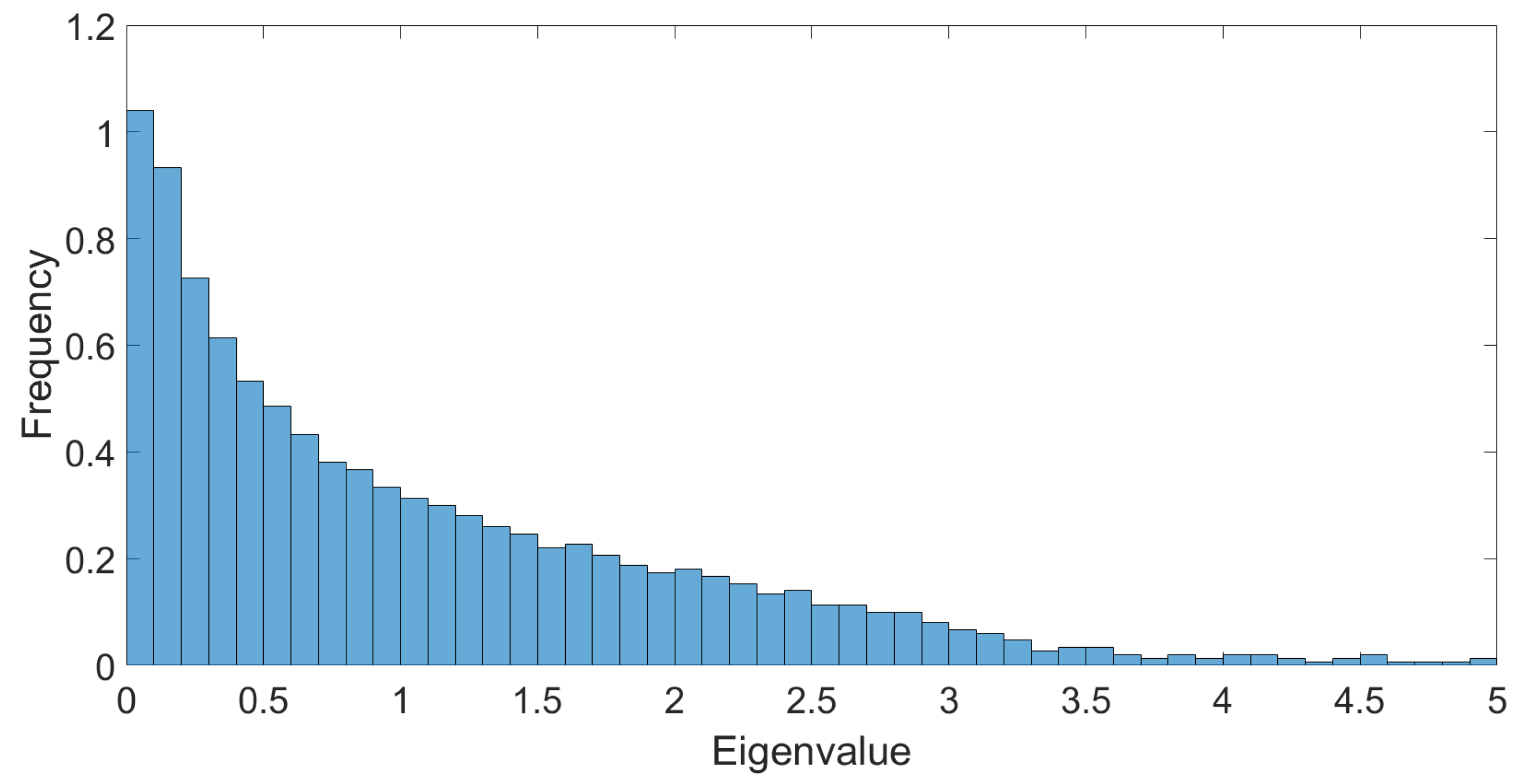
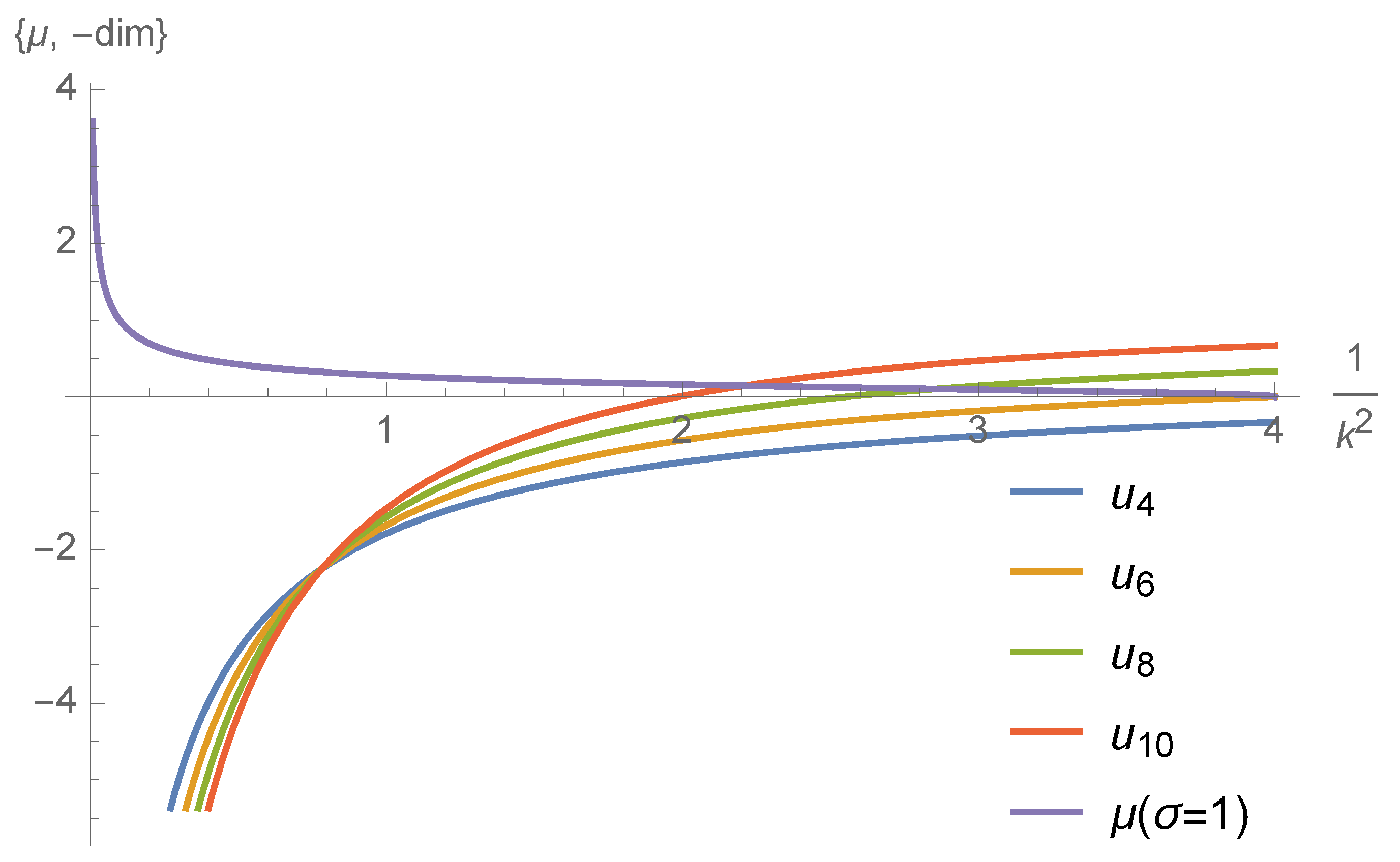
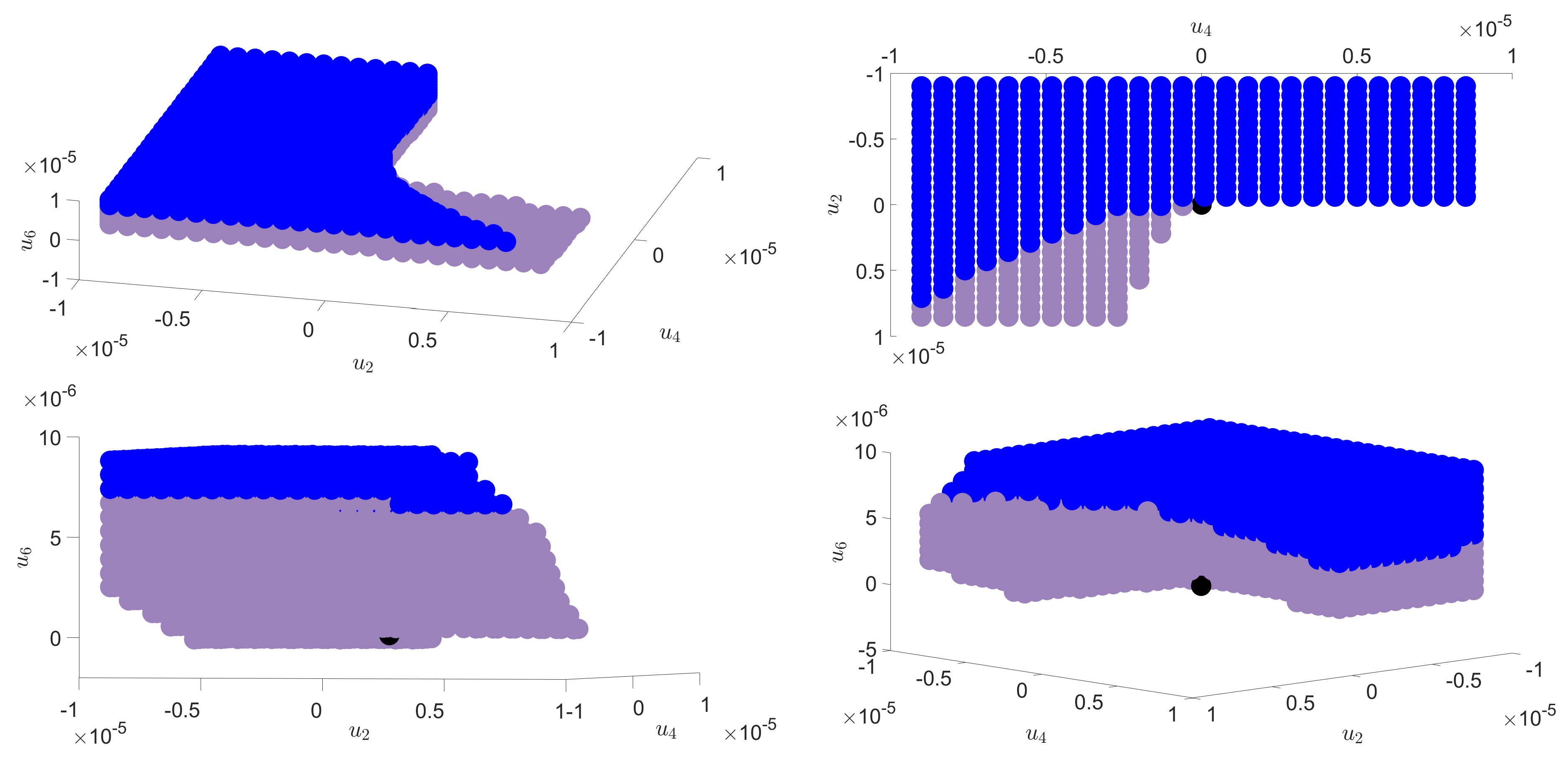
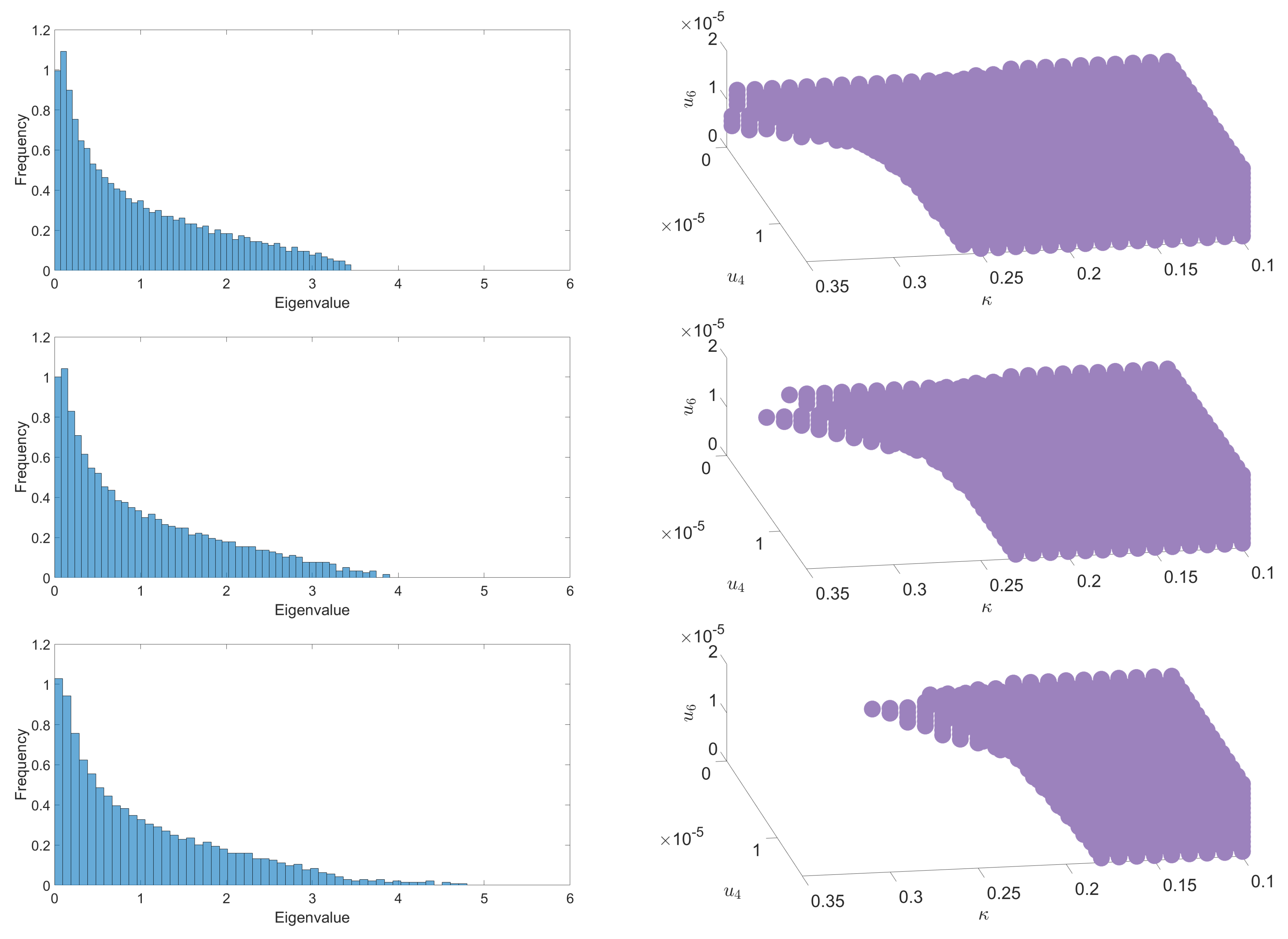

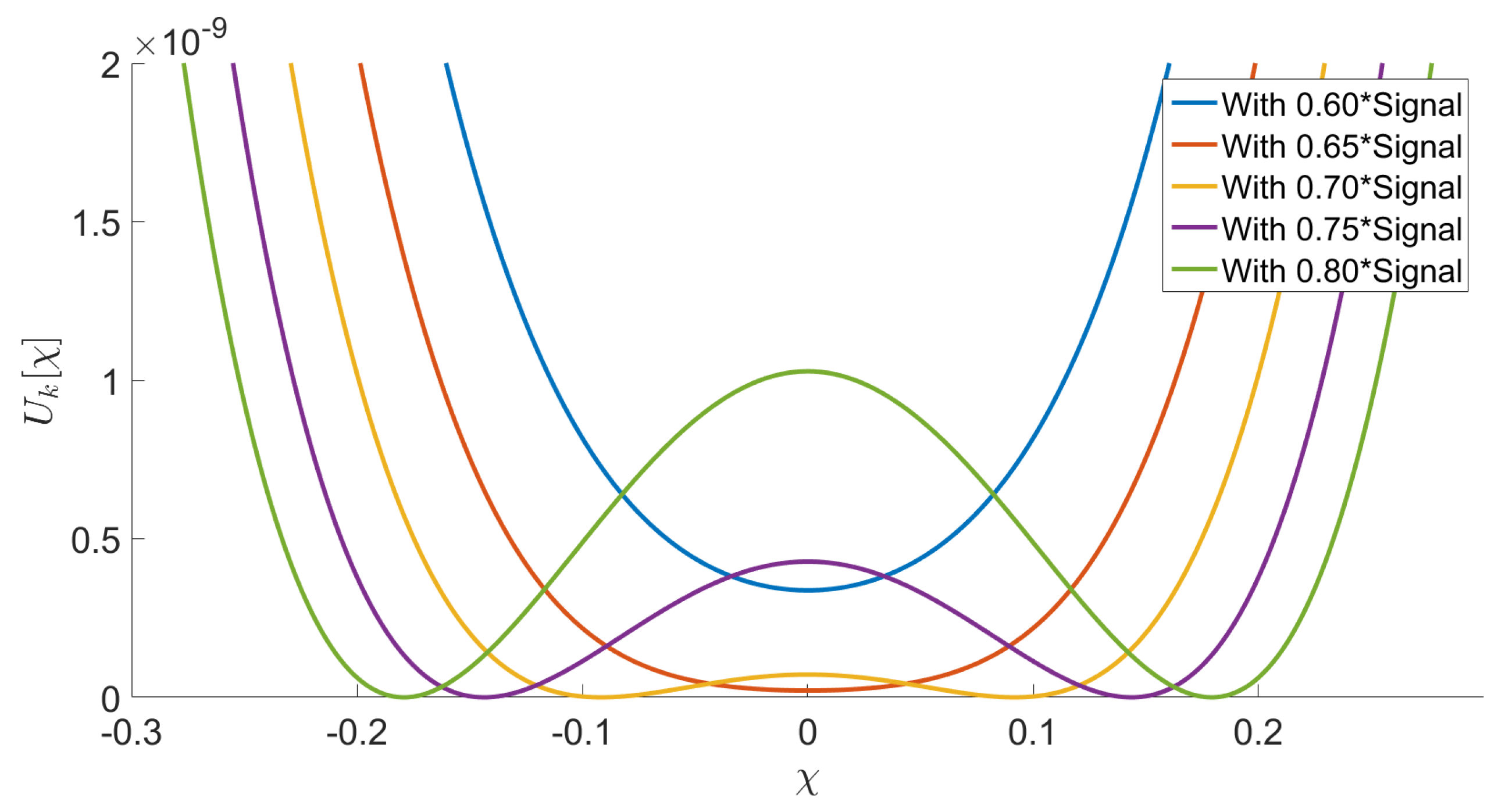
Publisher’s Note: MDPI stays neutral with regard to jurisdictional claims in published maps and institutional affiliations. |
© 2022 by the authors. Licensee MDPI, Basel, Switzerland. This article is an open access article distributed under the terms and conditions of the Creative Commons Attribution (CC BY) license (https://creativecommons.org/licenses/by/4.0/).
Share and Cite
Lahoche, V.; Ousmane Samary, D.; Tamaazousti, M. Signal Detection in Nearly Continuous Spectra and ℤ2-Symmetry Breaking. Symmetry 2022, 14, 486. https://doi.org/10.3390/sym14030486
Lahoche V, Ousmane Samary D, Tamaazousti M. Signal Detection in Nearly Continuous Spectra and ℤ2-Symmetry Breaking. Symmetry. 2022; 14(3):486. https://doi.org/10.3390/sym14030486
Chicago/Turabian StyleLahoche, Vincent, Dine Ousmane Samary, and Mohamed Tamaazousti. 2022. "Signal Detection in Nearly Continuous Spectra and ℤ2-Symmetry Breaking" Symmetry 14, no. 3: 486. https://doi.org/10.3390/sym14030486
APA StyleLahoche, V., Ousmane Samary, D., & Tamaazousti, M. (2022). Signal Detection in Nearly Continuous Spectra and ℤ2-Symmetry Breaking. Symmetry, 14(3), 486. https://doi.org/10.3390/sym14030486




